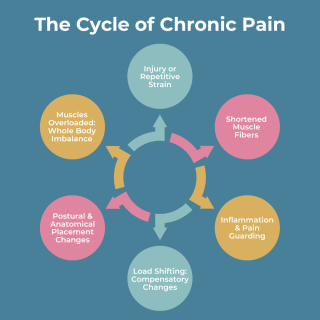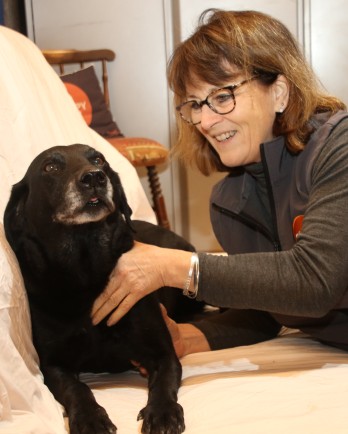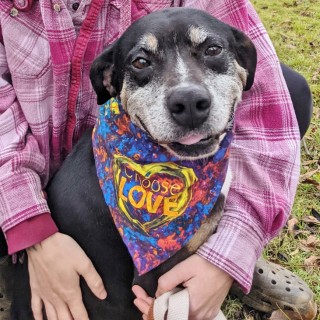Improving Your Dog's Mobility
As dogs age, so do their muscles and joints. To help improve mobility, Julia Robertson recommends Galen Myotherapy, a canine massage and exercise rehabilitation therapy, to help with chronic conditions and pain management.
The Ins & Outs of Galen Myotherapy
Myotherapy focuses specifically on soft tissue, like muscles and the myofascial system. Fascia is connective tissue surrounding and holding every organ, bone, and muscle in place. Some call the myofascial system the “soft skeleton” of the body. But beyond providing internal structure, fascia also has nerves, making it sensitive to stress.
Together, muscles and fascia form a chain throughout your dog’s body. This is why Galen Myotherapy focuses on treating the whole dog and accurately identifying the root cause of pain.
Assessing a Dog’s Condition
There are many different things we can look for in assessing our pet’s mobility and the possible presence of chronic conditions or pain.
1. Functional Biomechanics: How many and what types of movement can your dog do? Julia suggests looking beyond their ability to walk in a straight line. Instead, consider how easily they can negotiate walking around objects or maneuver their head and neck.
2. Posture: A dog with balanced mobility should appear symmetrical when looking at them from the front or back. Curves in the spine, a tail positioned to one side, or even uneven ears can be signs that a dog is dealing with mobility issues or pain.
3. Behavior: Dogs, just like people, will alter their behavior to reduce their exposure to pain. Avoiding crowded areas of the home with tight spaces, hesitating to use stairs, or moving efficiently rather than for enjoyment on walks may indicate that your dog is struggling with routine motions.
4. Change in Appearance: Coat changes and the state of a dog’s nails and feet can tell us a lot about how they are feeling.
The Cycle of Chronic Pain

One of the most common diagnoses for older dogs is arthritis or joint pain. But what most people don’t realize is that medical professionals consider arthritis to be a secondary disease to lameness. This means that sometimes, the root cause of joint pain is an injury or repetitive strain on a nearby muscle that sets off a chain of reactions leading to chronic pain. The “cycle of chronic pain” looks like this:
1. Injury or Repetitive Strain
2. Muscle fibers shorten and tighten in response, creating an uneven pull on nearby joints.
3. The resulting tightness creates inflammation or pain
4. Pain Guarding: The dog will shift the load to other muscles to reduce pain.
5. Compensatory Shifting: The dog tries to compensate for the injury or strain by putting more weight on the opposite side.
6. Postural Changes: The uneven weight load causes the dog’s entire anatomy to shift, resulting in a visibly uneven posture.
7. Whole-Body Imbalance: Muscles become overloaded, creating imbalances across the entire body.
8. Secondary Injury or Repetitive Strain: Without proper treatment, the dog is at much higher risk for a secondary injury or strain due to the increased stress on its muscles and joints.
Julia notes that muscles cannot repair themselves, so rest isn’t always the best option. Just as a bone needs to be set before healing correctly, muscles must be manually repaired via physical therapy and appropriate exercise. Otherwise, they risk forming scar tissue, which will only limit mobility in the muscle further.
Easy Ways To Help At Home
The good news is that we can do many simple things for our dogs to help them immediately.
1. Invest in non-slip rugs and place them throughout the home to create safe pathways for aging dogs. This is most important in front of their food bowls and favorite beds or sleeping areas.
2. Reduce lengthy or inconsistent exercise. Long walks or walks that are inconsistent in length and difficulty make it hard for your dog to adjust. Opt for short, “sniffy” walks instead! Ten to fifteen minutes of sensory exercise encourages dogs to move their body more naturally, stopping to sniff at interesting smells, curving around objects, and moving at their own pace.
3. Ditch the sit: Avoid asking your older dog to “sit.” Dogs usually only sit naturally when thinking or looking at something. Otherwise, they tend to lie down or stand on all fours. Sitting is a surprisingly impactful movement for dogs, especially as they age. Many older dogs struggle with lifting their hindquarters out of the sitting position - so it’s best not to ask them to do it unless absolutely necessary.
4. Enrich their environment: Give your dog a free-flowing sensory atmosphere to explore safely and without worry. You want to encourage constant movement, so avoid items that would encourage them to spend too much time in one area. Remember, less is more!
5. Skin Rolling: One of the techniques used by Galen Myotherapy is skin rolling, where owners or trained professionals lift and move a dog’s skin to encourage mobility and reduce the stiffening of the fascia. Galen has an excellent instructional video {insert link} to help you get started!
6. Effleurage: This stroking technique involves using a flat hand and consistent pressure to increase circulation. It can be a great gateway technique to skin rolling. Julia cautions owners to avoid the spine, as pressure on a dog’s vertebrae can be, at best, uncomfortable and, at worst, downright painful. A guided video of the effleurage technique can be found here.
Choice-Based Therapy
Julia emphasizes that a choice-based approach is the best way to engage in mobility-increasing activities with your dog. We want our dogs to feel comfortable and safe, so she recommends setting aside a specific time to explore your pet’s mobility. It can be helpful to designate a working space and give your dog the option and freedom to leave the space whenever they feel uncomfortable. Once dogs realize their participation is not mandatory, they are more likely to engage in the activity willingly.
If your dog shows any acute signs of stress or pain, it's important to get them to a vet for proper diagnosis and treatment. Your dog’s acute pain must be managed for skin rolling, effleurage, enrichment, or exercise to be effective.
Next Steps
Galen Myotherapy offers many resources to pet parents hoping to improve their dog’s mobility, including an introductory course in canine massage and visual assessment and a distance support program, which allows a Galen staff member to evaluate your dog remotely and provide helpful suggestions. For more information, you can visit their website at: www.galenmyotherapy.com
About The Presenter
Julia Robertson has treated dogs with degenerative musculoskeletal issues for over 20 years. She is an expert in interpreting postural and physical changes in dogs suffering from muscular pain.
Julia is a published author and the founder of Galen Myotherapy, an independent education provider that provides online and practical courses for guardians and canine professionals. She is passionate about educating others on how to treat the effects of adaptive change (or muscular compensation) to improve the lives of dogs.



